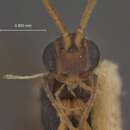Distribution
provided by Catalog of Hymenoptera in America North of Mexico
Que., N. Y., Md., W. Va., Va., Ont., Colo.
- bibliographic citation
- Catalog of Hymenoptera in America North of Mexico. 1979. Prepared cooperatively by specialists on the various groups of Hymenoptera under the direction of Karl V. Krombein and Paul D. Hurd, Jr., Smithsonian Institution, and David R. Smith and B. D. Burks, Systematic Entomology Laboratory, Insect Identification and Beneficial Insect Introduction Institute. Science and Education Administration, United States Department of Agriculture.
Comprehensive Description
provided by Smithsonian Contributions to Zoology
Orgilus macrurus
The combination of characters given in the key will distinguish this species from those most similar to it. The ovipositor is unusually long, being longer than in any other species of Orgilus known to me.
FEMALE.—Length around 3.5 mm. Head wider than thorax, in dorsal view nearly twice as wide as long, weakly excavated behind; face just about as broad as eye height, shiny, and with some scattered punctures medially; clypeus strongly convex, not separated from the face medially; anterior tentorial pits very deep and on a line with lower eye margins; malar space about one-fourth as long as eye height; cheeks finely granulose and mat; temples about half as wide as eyes, somewhat convex, receding; occipital carina interrupted medially; ocellocular line a little longer than distance between the lateral ocelli and nearly or quite twice as long as the diameter of one of them; antennae 38- or 39-segmented in the available female specimens with complete antennae, even the shortest flagellar segments at least as long as broad, the apical segment with a very short, sometimes indistinct, terminal spicule.
Thorax slender, 2.5 times as long as wide; mesoscutum smooth and shiny, without a rugulose area at the junction of the notauli, which are finely foveolate; the middle lobe a little punctate anteriorly; disc of scutellum rather flat and with a few weak punctures; propodeum only a little declivous caudad, usually finely rugulose over most of its surface but sometimes granulose or even nearly smooth laterally, the stubs of the carinae that arise from the posterior margin of propodeum in many species of the genus not distinct; side of pronotum granulose below the impression, coriaceous above it; prepectal carina weak; mesopleuron smooth and polished, the longitudinal furrow nearly straight, finely foveolate; metapleuron weakly, indefinitely sculptured anteriorly, more or less rugulose posteriorly and below. Hind coxa two-thirds as long as hind femur, finely coriaceous and rather mat; hind femur four times as long as broad; longer calcarium of hind tibia not more than half as long as metatarsus; tarsal claws simple. Stigma only slightly shorter than radial cell on wing margin; second abscissa of radius very nearly on a line with intercubitus; stub of third abscissa of cubitus punctiform; nervulus always postfurcal, sometimes by nearly half its length; hind wing usually about 4.6 times as long as wide; lower abscissa of basella a little more than half as long as mediella.
Abdomen slightly longer than thorax; first tergite 1.5 times as long as broad at apex, largely finely granulose or shagreened but smooth at base, the basal dorsal keels distinct but weak; second and following tergites smooth, the second not quite as long as broad at base; second suture very weak, sometimes barely apparent; ovipositor sheath more than twice as long as head, thorax, and abdomen combined.
Black or blackish, palpi yellow, sometimes darkened basally; face and antennae brownish; tegulae yellow; wings hyaline; legs testaceous, the tarsi darkened and sometimes also the hind femora and tibiae more or less; abdomen brownish yellow medially, the first tergite except apically, and the fifth and following tergites, darkened.
MALE.—Legs usually somewhat darker than in the female; antennae of the available male specimens 43- or 44-segmented.
HOLOTYPE.—USNM 70177.
DISTRIBUTION.—The holotype is from Plummers Island, Maryland, collected 28 June 1961, by K. V. Krombein. Paratypes (24 in all) are from various localities in Maryland, Virginia, West Virginia, New York, Colorado, Quebec, and Ontario.
- bibliographic citation
- Muesebeck, Carl F. W. 1970. "The Nearctic species of Orgilus Haliday (Hymenoptera: Braconidae)." Smithsonian Contributions to Zoology. 1-104. https://doi.org/10.5479/si.00810282.30

